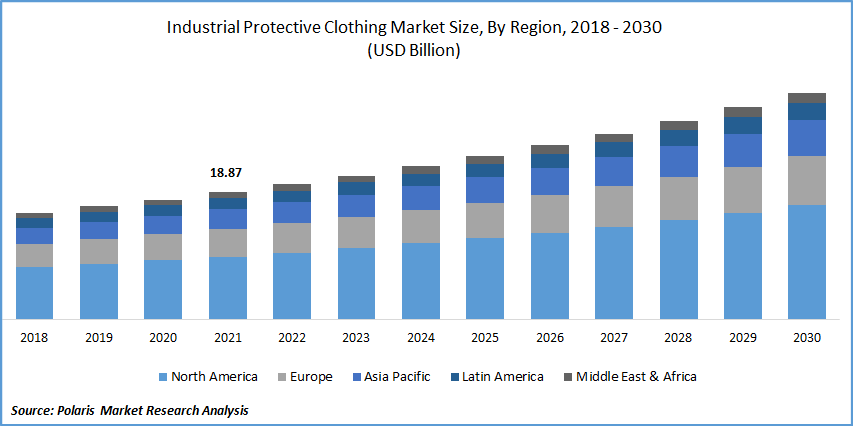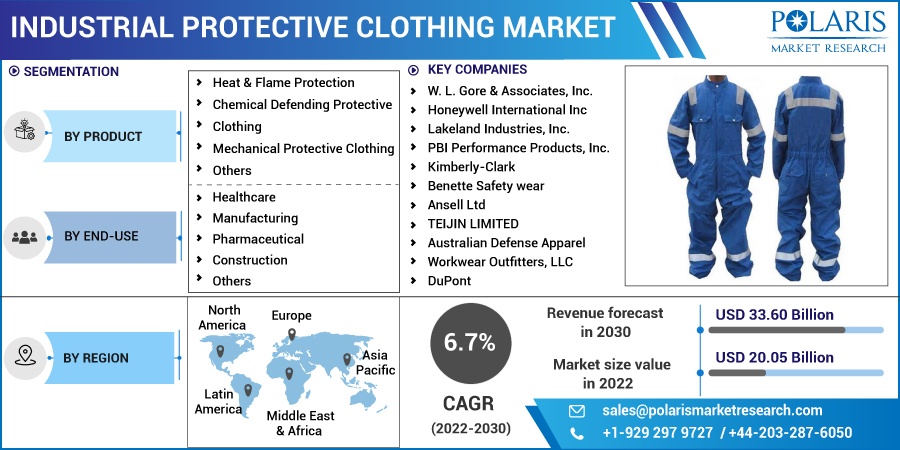
Industrial Protective Clothing Market Share, Size, Trends, Industry Analysis Report
By Product (Heat & Flame Protection, Chemical Defending Protective Clothing, Mechanical Protective Clothing, Others); By End-use; By Region; Segment Forecast, 2022 - 2030
- Published Date:Dec-2022
- Pages: 118
- Format: PDF
- Report ID: PM2947
- Base Year: 2021
- Historical Data: 2018-2020
Report Outlook
The global industrial protective clothing market was valued at USD 18.87 billion in 2021 and is expected to grow at a CAGR of 6.7% during the forecast period.
The market's promising growth potential is attributed to the growing understanding of the necessity of preventing deadly workplace accidents is projected to fuel market expansion. Governments worldwide have mandated using industrial protective equipment to reduce the risk of infection. Most healthcare workers use industrial protective garments to protect their health in light of the COVID-19 epidemic. The demand for industrial protective apparel has consequently increased.

Know more about this report: Request for sample pages
Industrial protective clothing is a category of apparel specially made to shield industry employees from risks, including heat, chemicals, and other pathogens. Materials like laminated polyesters, polyolefin, laminated polyesters, aramid, and others are used to make these garments.
To protect workers from occupational risks, expanded onshore and offshore drilling operations and increased shale gas production in the United States are predicted to raise demand for industrial protective apparel. Local shale production in the area is projected to rise even more as a result of ongoing advancements in government attempts to strengthen the nation's energy independence.
Additionally, the nation has a sizable workforce engaged in oil and gas operations, necessitating the usage of premium protective clothing. The expansion is anticipated to be aided by establishing regulatory bodies like the Occupational Safety and Health Administration (OSHA) and strict labor laws.
To protect workers exposed to the Covid-19 virus, fashion conglomerates, luxury companies, and designers also manufacture PPE, including masks, face shields, and protective apparel. For instance, in April 2020, the German multinational manufacturer of footwear, clothing, and accessories, Adidas, teamed up with the American 3D printing company Carbon to create 3D-printed face shields to help combat the pandemic issue.
The rapid industrialization of developing nations, the rise in manufacturing activities worldwide, and the development of worker safety regulations are the main forces anticipated to propel global market expansion. An additional aspect expected to boost the growth of the target market is the significant investment made by leading players in product development and the growing need for lightweight and versatile items.
 Know more about this report: Request for sample pages
Know more about this report: Request for sample pages
Industry Dynamics
Growth Drivers
The need for protective clothing is rising due to workers' growing safety concerns in the chemical, oil and gas, construction, and manufacturing industries, as well as a rise in public awareness of the need to reduce workplace fatalities and industrial accidents.
The existence of strict labor laws also influences the market, governing organizations, an increase in the working population due to the manufacturing sector's rapid expansion, and other factors. Additionally, urbanization, industrialization, and expanding infrastructural developments in emerging economies positively impact the market for industrial protective apparel.
The main drivers of industrial protective clothing market expansion worldwide are an increase in workplace accidents, deaths, and injuries, tighter government regulation, and an adequate supply of protective apparel. The manufacturing industries dominate the global market for protective clothing. However, the healthcare sector is anticipated to grow with a sizable CAGR over the forecast due to rising demand in laboratories, pharmaceutical firms and during the Covid-19 outbreak.
Report Segmentation
The market is primarily segmented based on product, end-use, and region.
|
By Product |
By End-use |
By Region |
|
|
|
Know more about this report: Request for sample pages
In 2021, the chemical defending protective clothing segment dominated the market, accounting for the largest market share.
Chemical protecting clothing shields workers from exposure to or contact with chemicals. The oil, gas, chemical, and healthcare industries use most of these items. Long-lasting industrial protective cloth is used in large enterprises where workers are subjected to harsh circumstances like radiation, pressure, and high temperatures. During the projected period, there is anticipated to be an increase in demand for durable industrial protective cloth to support the continuous safety of labor.
During the forecast period, the demand for heat and flame protection apparel is anticipated to increase at a high CAGR. This is due to the expanding construction, oil and gas, chemical, and firefighting industries, notably in Asia Pacific's emerging economies like China, India, and Vietnam, as well as the product's penetration in these sectors.
The manufacturing segment is expected to hold the significant revenue share
New factories and plants have been built in many nations due to the expanding labor force, which is anticipated to drive the industrial protective clothing market over the projected period. Additionally, the industry's growing workforce is projected to increase demand for products that protect workers and reduce overhead expenditures like compensation.
The healthcare segment dominated the market share as the utilization of medical services worldwide is anticipated to benefit from the acceptance of novel procedures and the creation of cutting-edge products. Additionally, it is expected that rising disposable income will enable developing nations to access cutting-edge medical services, driving up costs in the healthcare sector.
Moreover, construction is anticipated to grow at a high CAGR during the forecast period; it is predicted that the overhead expenses related to workplace fatalities or injuries will increase demand for protective apparel in the construction industry. Throughout the forecast period, it is anticipated that the expanding construction sector, particularly in Germany and the UK, will increase demand for the product.
The demand in North America is expected to witness significant growth.
In recent years, the usage of industrial protective clothing in the region has expanded due to the increased use of flame-retardant clothing in the chemicals, oil & gas, metals, and pulp & paper industries.
In the Asia Pacific region, the demand for high utility, high durability, and mechanical wear resistance industrial protective clothing is expected to outpace demand over the forecast period. These factors are expected to increase occupational fatalities and drive up industrial protective clothing requirements. Factors like the expanding construction sector, which includes the construction of ports, flats, buildings, and hotels, are projected to be the main drivers of demand for this product.
Competitive Insight
Some of the major players operating in the global market include W. L. Gore & Associates, Inc., Honeywell International Inc, Lakeland Industries, Inc., PBI Performance Products, Inc., Kimberly-Clark, Benette Safety wear, Ansell Ltd, TEIJIN LIMITED, Australian Defense Apparel, Workwear Outfitters, LLC, DuPont, TenCate Protective.
Recent Developments
- Honeywell International Inc. launched a production line for N95 face masks in India in August 2020. Along with continuing to produce innovative face masks, the new manufacturing facility will focus on providing automation solutions, field instruments, and testing and manufacturing tools for the process industries.
Industrial Protective Clothing Market Report Scope
|
Report Attributes |
Details |
|
Market size value in 2022 |
USD 20.05 billion |
|
Revenue forecast in 2030 |
USD 33.60 billion |
|
CAGR |
6.7% from 2022 – 2030 |
|
Base year |
2021 |
|
Historical data |
2018 – 2020 |
|
Forecast period |
2022 – 2030 |
|
Quantitative units |
Revenue in USD billion and CAGR from 2022 to 2030 |
|
Segments Covered |
By Product, By End-use, By Region |
|
Regional scope |
North America, Europe, Asia Pacific, Latin America; Middle East & Africa |
|
Key Companies |
W. L. Gore & Associates, Inc., Honeywell International Inc, Lakeland Industries, Inc., PBI Performance Products, Inc., Kimberly-Clark, Benette Safety wear, Ansell Ltd, TEIJIN LIMITED, Australian Defense Apparel, Workwear Outfitters, LLC, DuPont, TenCate Protective. |
FAQ's
The global industrial protective clothing market size is expected to reach USD 33.60 billion by 2030.
Key players in the industrial protective clothing market are W. L. Gore & Associates, Inc., Honeywell International Inc, Lakeland Industries, Inc., PBI Performance Products, Inc., Kimberly-Clark, Benette Safety wear.
North America contribute notably towards the global industrial protective clothing market.
The global industrial protective clothing market expected to grow at a CAGR of 6.7% during the forecast period.
The industrial protective clothing market report covering key segments are product, end-use, and region.
